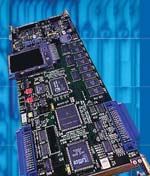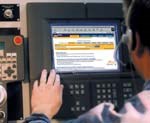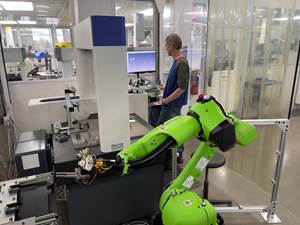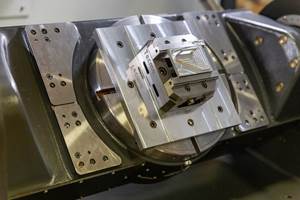Bringing The Internet To The Machine Tool
The Internet integrates the factory floor with customers and suppliers, allowing true Enterprise Production Management. The concept of "virtual product" replaces the conventional practice of warehousing inventory.
To be competitive today, manufacturers must manage not only their own internal operations well, but they must also understand and manage all aspects of their external environment that affect production. Real-time two-way communication with the factory floor via the Internet gives managers up-to-the-minute information when they need it, wherever they happen to be. In industry, the Internet promises to connect the enterprise with suppliers and vendors enabling a new paradigm in manufacturing—Enterprise Production Management (EPM).
The use of the Internet will soon force companies to manage production across the extended enterprise. Ordering online is allowing customers to purchase a product tailored to their needs. This custom ordering is shifting manufacturing away from one order of 1,000 units to a 1,000 orders of different variations of a product. Maintaining inventory in a warehouse is no longer possible because the product must be made-to-order. However, the product must be delivered to the customer in an acceptable timeframe so that it feels like the product came from a warehouse. This concept of manufacturing the product after the order is received is called the "virtual product" because the product does not actually exist until after the customer places the order.
In order to create virtual products, it is essential that a company practice EPM. To do so requires a company to have all of its systems connected down to the level of the machine tool inside its divisions and to its extended enterprise, its suppliers. When an order is received, the ERP system communicates electronically with all machines in the supply chain. This new communication of manufacturing information takes supply chain management (SCM) to a new level, a level beyond just electronic purchasing and invoicing. A customer order results in an immediate capacity assessment of what machine time is available in the supply chain. Machining instructions are automatically downloaded to the appropriate machines so that they can begin part production even as the order processing is taking place. Electronically linking the ordering process to the manufacturing process is the link that will enable companies to stock virtual products instead of maintaining inventory. The connection between business-to-business systems and the factory floor may be referred to as factory to business or F2B.
Most of the investment in e-commerce over the past 5 years has been focused on improving the connection between company divisions for the purpose of Enterprise Resource Planning (ERP). Other e-commerce investments include connecting vendor and supplier accounting systems electronically and connecting electronically to customers to improve customer service. Today's ERP systems now manage a company's machines and materials in a static manner and proceed to schedule with specific times and dates, often relying upon the efforts (often heroic) of human managers to keep things running. These initiatives ignore connecting to the devices that make up the bulk of the company's capital investment, the machines on the factory floor. These machines contain a wealth of information about what is happening right now, yet this information is not accessible and as a result cannot be used to make critical decisions.
The CNC As Barrier Or Enabler
To achieve EPM, all machines in the factory must be connected and able to broadcast their status. In the realm of discrete manufacturing, most metalworking shops employ machine tools with computerized numerical control (CNC) systems. Although more than 2 million CNCs are now in production, most have only basic serial communications at low data transfer (baud) rates. The serial connection itself uses proprietary protocols for communication. No communications standard has ever been developed because the CNC has up until now been viewed as a downstream device that processes G-code and controls motion on a machine tool or robot. Most of the machines in production today were created before the Internet explosion took place.
There are several barriers for the introduction of the Internet to the factory floor. No one in an office environment would imagine using a computer that is 8 or 9 years old. In 1993, the so-called 486 central processing unit provided the fastest personal computer on the market. The Pentium-based P60 and P90 processors were introduced in 1994. Office computers are routinely replaced every 3 years, an action justified by the increased productivity available to of the user.
In contrast, the lifespan of the CNC, the computer which controls the motion of the machine tool, is determined by the lifespan of the machine tool itself. Machine tools represent the most significant assets a metalworking company has. As long as a machine tool is productive and able to cut metal in an acceptable manner, most shops continues to use it as is. Replacing the CNC unit on the machine tool is expensive and rarely justified because the replacement may not improve the performance of the machine tool itself. In fact, the original CNC was developed and tuned to maximize the performance of the machine.
The core competency of CNC vendors is developing the best control system for optimal operation of the machine tool it is installed on. While most CNC vendors have an Internet strategy, few have the expertise to develop an open, scalable, Internet ready line of CNC models. Virtually all of the controls developed over the past 15 years (some two million worldwide) lack any Ethernet connection, a basic requirement for effective network connection. Some newer controls developed with an Ethernet connection lack the software protocols to communicate effectively over the Internet. Most Ethernet connections were provided simply to facilitate faster downloading of G-code data to the control for applications such as high speed machining.
Bridging The Gap
Recent CNC controls and PC software-based controls have come to market with an option for Ethernet connectivity. They also support the appropriate protocols to provide information needed for EPM. However, most CNCs are still solitary islands of technology. To bridge this gap, several companies are looking to the Open Modular Architecture Controls (OMAC) group in North America for its proposed web-centric Global HMI Protocol, which is based upon an eXtensible Markup Language (XML) schema. OMAC was formed in an effort to move away from proprietary control technologies, non-common user interfaces and the need for special training. The Global HMI sub-committee aims to create a common user interface and a common language for the communication with any control. The extensibility and scalability of XML makes it the ideal language upon which to establish future Web-based two-way communication with existing CNCs.
Another important communications standard is OLE for Process Control (OPC). Recently OLE has been restructured by Microsoft from object-oriented to object-based and renamed to Active-X. The OPC specification is a non-proprietary technical specification that defines a set of standard interfaces based on Microsoft's OLE/COM technology. The application of the OPC standard interface makes possible interoperability between automation/control applications, field systems/devices and business/office applications. The Active-X/COM technologies define how individual software components can interact and share data.
When all CNC machines in the supply chain, whether these machines are recently installed or not, have been securely connected in a local area network and are accessible with this OMAC protocol and sharing data using OPC, it finally will be possible to monitor production in real-time. This capability ushers in EPM. Gone are the days of reports generated daily, weekly or even monthly after the fact. This new level of inter-connectivity between local and remote nodes should prove to enable the enterprise to compete effectively in the F2B world of tomorrow.
The Virtual Product
With CNC machines integrated through Internet-enabled EPM, the truly made-to-order virtual product becomes a reality. The virtual product is actually a logical extension of JIT (just in time) production. Instead of producing enough parts to meet a projected order level, the part is produced only after a real order is processed. Because no finished-goods inventory exists, the key to obtaining cost-effective and timely virtual product systems is an integrated information technology (IT) infrastructure.
All large organizations have an IT department, and most have succeeded in connecting their business systems electronically across divisions using the Internet as the network backbone. The next logical extension of the corporate network is to connect the factory floor and to extend the Internet connection to their suppliers.
This virtual world means an order for a product, such as an automobile, will soon begin with little or no human intervention—utilizing the Internet. The entire design and production cycle will need to be online. EPM systems must be able to communicate with every machine on the shop or plant floor—a challenge only now being conquered. EPM systems will start a process, track its progress and determine when the finished car will be ready for delivery.
Automated optimization can also take into account unplanned production problems—such as machines breaking down, inventory not arriving, or even excess capacity not being utilized. To manage production for maximum efficiency, a company must be able to continuously monitor the shop floor and feed this information back in real-time to existing scheduling and planning systems. With accurate, instantaneous information from the machines on the floor, companies will then be able to re-route jobs dynamically to alternative machines or process stations and keep production running smoothly with little human intervention. The system may search for and enlist substitute resources, and immediately "push" new job orders down to the affected machines—even if they are in another plant or even in another country.
Disarming Bottlenecks
To see how an enterprise integrated with two-way communication to the plant floor can increase productivity, one need only look at the process manufacturing industry. Most of the machines in a process manufacturing environment, such as food processors or raw material refineries, employ programmable logic controllers (PLCs). The PLC is a device that can be monitored for its current state, typically indicating whether a particular switch is on or off. Most PLC vendors now support OPC, so they have written applications to gather data and report the information to management. These applications are now becoming quite mature, and some are even available off-the-shelf, although most are still customized for the application being monitored.
In many cases, the return on investment in this technology has been dramatic. The key is being able to interface Manufacturing Execution Systems (MES) software to ERP systems. Together, this software is used to apply management concepts based on theory-of-constraints to the factory floor. Using real-time data, managers can easily identify and monitor bottlenecks. The bottleneck is not eliminated, but rather, throughput at the bottleneck is optimized, and all other systems adjusted to the speed of the bottleneck.
Using the open standards proposed by EPM, it is possible to gather data from CNCs on the factory floor. The previously closed world of CNCs is opened up, allowing bottlenecks to be identified and monitored as effectively in discrete parts manufacturing as they are in the process industries.
Utilizing the Internet, information can be gathered from the extended enterprise allowing real-time decisions to be made. Manufacturing capacity can be planned across multiple plant locations and even multiple companies in the supply chain. Scheduling can be kept up-to-date with machines feeding production information directly into front office applications. Bottlenecks in the enterprise can be identified, and ultimately throughput can be optimized in order to maximize productivity and profits for the entire supply chain.
About the author. Tom Gaasenbeek is president of e-Manufacturing Networks Inc. in Burlington, Ontario, Canada
Related Content
Beyond the Machines: How Quality Control Software Is Automating Measurement & Inspection
A high-precision shop producing medical and aerospace parts was about to lose its quality management system. When it found a replacement, it also found a partner that helped the shop bring a new level of automation to its inspection process.
Read MoreShop Moves to Aerospace Machining With Help From ERP
Coastal Machine is an oil and gas shop that pivoted to aerospace manufacturing with the help of an ERP system that made the certification process simple.
Read MoreDiving Deeper Into Machine Monitoring Data
Data visualization is the first step in using machine monitoring data, but taking it to the next level requires looking for trends within the data.
Read MoreHow this Job Shop Grew Capacity Without Expanding Footprint
This shop relies on digital solutions to grow their manufacturing business. With this approach, W.A. Pfeiffer has achieved seamless end-to-end connectivity, shorter lead times and increased throughput.
Read MoreRead Next
The Cut Scene: The Finer Details of Large-Format Machining
Small details and features can have an outsized impact on large parts, such as Barbco’s collapsible utility drill head.
Read More3 Mistakes That Cause CNC Programs to Fail
Despite enhancements to manufacturing technology, there are still issues today that can cause programs to fail. These failures can cause lost time, scrapped parts, damaged machines and even injured operators.
Read More












.png;maxWidth=300;quality=90)




.png;maxWidth=300;quality=90)













